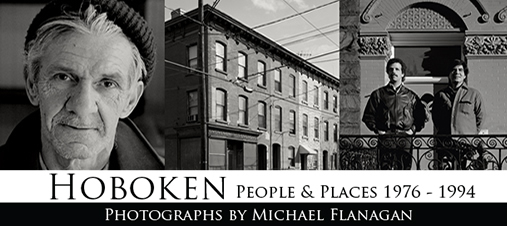Hoboken People and Places, 1976-1994: Photographs by Michael Flanagan
January 22 – July 2, 2017

When he moved to Hoboken in the mid-1970s, Michael Flanagan was already a seasoned photographer with a passion for developing his own prints through meticulous experimentation.
His camera of choice was a large format, four-by-five-inch Linhof view camera, mounted on a tripod. The equipment was bulky and cumbersome, but under his skilled hands, it yielded crisp, detailed black and white images. He even toted this same camera and tripod on his many trips abroad.
From 1976 to 1994, Flanagan lived near the corner of Bloomfield and 10th Streets, and many of his photographs document the changing storefronts of this uptown location. He was determined to capture a feature of Hoboken life that was swiftly fading during the course of that decade: Mom-and-Pop shops, and the blue-collar residents that populated the city.
Only a few of the corner businesses recorded in Flanagan’s photos survive today: Lisa’s Deli, Truglio’s Meat Market, and, on the northeast corner of his block, the Bloomfield Launderette. Through his photographs we can see what has long been lost: Pierro’s Butcher Shop before it closed, and its owner, Al Pierro, during its last days. Today, it’s a kids’ yoga studio.
On the southeast corner, we see the interior and exterior of Kusseluk’s Shoe Store, which maintained an ancient display of footwear during the years Mike lived in the neighborhood. That it remained open at all during the 1980s was paradoxical, as potential customers would have to beg Sam Kusseluk to sell them a pair of shoes-—and rarely succeeded. Today, the building hosts Anthony David’s restaurant and an adjacent tattoo parlor.
Opposite Kusseluk’s was Nellie’s Store, where a customer might find just about anything available at the city’s one big supermarket, but in smaller quantities. Like so many who owned and ran the corner stores in Hoboken in the 1980s, Nellie lived in the building, and seemed to be in the shop night and day, offering warm greetings along with candy bars, cans of soup, and cartons of milk.
Flanagan photographed other longtime residents: barkeeps, plumbers, mailmen, retired longshoremen, and many seniors, often snapped while sitting in folding chairs on the sunny side of the sidewalk, as if the public pathway were a corner of their own backyard. Some were known as the “mayors” of their block-—the characters, the ones who told the best stories, the ones you sought out when you wanted to learn the news behind the news. One barkeep he photographed, “mayor” Tom Vezzetti, actually became Mayor of Hoboken in 1985.
Like most photographers, Mike did not set out to create a comprehensive visual record of the city. There are, for example, no photographs of the music scene at Maxwell’s, which was at its height during the late 1970s and 1980s, and there is but one image that attests to the spate of arson that terrified Hoboken’s tenement dwellers during the same period. It is a haunting memorial for the eleven tenants, including seven children, who died in the 1981 fire in the Eldorado on 12th Street.
But in their close observation of textures and absences and the uses of public space, Flanagan’s photographs allow current residents and visitors to reflect upon significant changes, over time, in the life and landscape of Hoboken. The exhibition also includes festival and political posters, t-shirts and video footage from the period, including the critically acclaimed “Delivered Vacant,” Nora Jacobson’s sensitive documentary showing the personal consequences of gentrification.
The most striking changes are visible in his images of the waterfront and of city parks. Hoboken’s young family population had declined by the 1980s, and some of the city’s old school buildings were sold for condominium development. The parks in that period were crumbling and seem nearly abandoned-—barely recognizable compared with the green, equipment-filled spaces that teem with activity today.
The Museum is indebted to the Estate of Michael Flanagan, for sponsoring this exhibition, with additional financial support from: Lizzy Flanagan; Michael Flanagan and Christine Allen; Abigail, Luke and Liam Flanagan; Liz Flanagan and Nancy Wilkinson; Hoboken Improvement Company; Justin Silverman; and Robert Foster; and thanks also to Steven and Lily Zane for their generous donation of Michael Flanagan’s photographs, negatives and slides to the permanent collection of the Hoboken Historical Museum.
